List of World Heritage Sites in Germany

Map of World Heritage Sites in Germany as of July 2016
There are 41 official UNESCO World Heritage Sites in Germany, 38 cultural and 3 natural, with one additional previous site struck from the list. In addition, there are 17 German entries in the Memory of the World Programme. Germany ratified the World Heritage Convention on 23 August 1976.[1]
World Heritage Sites in Germany
| Site | Image | Location | Criteria | Area ha (acre) | Year | Description |
|---|---|---|---|---|---|---|
| Aachen Cathedral | 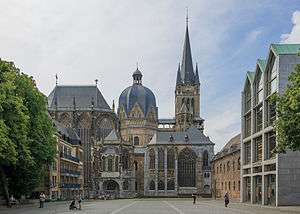 | Aachen, 50°46′28″N 6°5′4″E / 50.77444°N 6.08444°E | Cultural: (i), (ii), (iv), (vi) | — | 1978 | An iconic feat of architecture that sparked copies around Germany for centuries to come, Aachen's cathedral became the first-built vaulted structure since antiquity. The town itself was closely tied to Charlemagne during the cathedral's inception, which explains why it became his burial place when he died in 814.[2] |
| Abbey and Altenmünster of Lorsch | 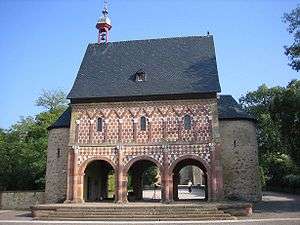 | Lorsch, 49°39′13.284″N 8°34′6.888″E / 49.65369000°N 8.56858000°E | Cultural: (iii), (iv) | — | 1991 | The abbey and gate or 'Torhall', are from the Carolingian era. The notable Carolingian sculptures and paintings are still in good condition.[3] |
| Bauhaus and its sites in Weimar and Dessau |  | Dessau and Weimar 50°58′29.172″N 11°19′46.164″E / 50.97477000°N 11.32949000°E | Cultural: (ii), (iv), (vi) | — | 1996 | Formed in 1919, the original Bauhaus school in Weimar was known for its role in the progression of modern art through its architecture. Although it was shut down in 1925 for political reasons, Walter Gropius was able to establish a second and much more influential Bauhaus in Dessau months later, eventually attracting world-renowned artists to teach at the school before once again closing in 1933.[4] |
| Bergpark Wilhelmshöhe |  | Kassel, 51°18′57″N 9°23′35″E / 51.31583°N 9.39306°E | Cultural: (iii), (iv) | 559 (1,380) | 2013 | Bergpark Wilhelmshöhe is the largest European hillside park, and second largest park on a mountain slope in the world. Its waterworks along with the towering Hercules statue constitute an expression of the ideals of absolutist Monarchy while the ensemble is a remarkable testimony to the aesthetics of the Baroque and Romantic periods.[5] |
| Berlin Modernist Housing Estates |  | Berlin, 52°26′54″N 13°26′59.9″E / 52.44833°N 13.449972°E | Cultural: (ii), (iv) | 88 (220) | 2008 | The property consists of six housing estates from 1910 to 1933. It is an example of the building reform movement that contributed to improved housing and living conditions for people with low incomes. The estates also showcase a number of new designs, decoration and layouts. The lessons learned here were applied on other projects around the world. Some of the notable architects on these house were; Bruno Taut, Martin Wagner and Walter Gropius.[6] |
| Carolingian Westwork and Civitas Corvey |  | Höxter, 51°46′41.1″N 9°24′34.1″E / 51.778083°N 9.409472°E | Cultural: (ii), (iii), (iv) | 12 (30) | 2014 | Carolingian Westwork and Civitas Corvey were erected between AD 822 and 885 in a largely preserved rural setting. The Westwork is the only standing structure that dates back to the Carolingian era, while the original imperial abbey complex is preserved as archaeological remains that are only partially excavated. The Westwork of Corvey uniquely illustrates one of the most important Carolingian architectural expressions. |
| Castles of Augustusburg and Falkenlust at Brühl |  | Brühl, North Rhine-Westphalia, 50°49′30.1″N 6°54′35.2″E / 50.825028°N 6.909778°E | Cultural: (ii), (iv) | 89 (220) | 1984 | Augustusburg Castle, the residence of the prince-archbishops of Cologne, and the Falkenlust hunting lodge are both examples of early German Rococo architecture.[7] |
| City Hall and Roland in Bremen market square | 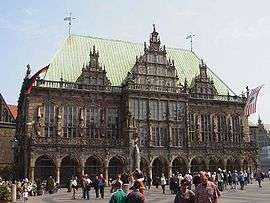 | Bremen, 53°4′33.5″N 8°48′26.9″E / 53.075972°N 8.807472°E | Cultural: (iii), (iv), (vi) | 0.29 (0.72) | 2004 | The site consists of the city hall and the statue of Roland that stands near it. The city hall was built in the 15th century when Bremen joined the Hanseatic League. It was renovated in the 17th century, and a new city hall was built nearby in the early 20th. Under the Holy Roman Empire, Bremen had extensive autonomy that allowed the town to grow and made the city hall a center of power. Both the old and new city halls survived bombings during World War II. The statue of Roland was built in 1404. It stands 5.5 m (18 ft) high.[8] |
| Classical Weimar |  | Thuringia, 50°58′39″N 11°19′42.996″E / 50.97750°N 11.32861000°E | Cultural: (iii), (vi) | — | 1998 | Weimar became a cultural center in the late 18th and early 19th centuries. Among the many artists and writers, the city was home to Goethe and Schiller. During this same period elegant buildings and parks were built in Weimar.[9] |
| Collegiate Church, Castle, and Old Town of Quedlinburg | | Harz, 51°46′59.988″N 11°9′0″E / 51.78333000°N 11.15000°E | Cultural: (iv) | — | 1994 | The preservation of old Quedlinberg allows tourists to see 16th- and 17th-century timber-framed houses and walk down medieval-patterned streets, while the Romanesque castle and cathedral, housing the bodies of Henry I and his wife, tower over the town.[10] |
| Cologne Cathedral | | Cologne, 50°56′28″N 6°57′26″E / 50.94111°N 6.95722°E | Cultural: (i), (ii), (iv) | — | 1996 | While work on the Cologne Cathedral began in 1248, it remained incomplete until the Prussians picked up the task centuries later, finishing the job in 1880. It was heavily bombed in the Second World War, but restorations allowed it to become the most visited landmark in Germany, boasting 6.5 million visitors per year as of 2011.[11][12] |
| Fagus Factory in Alfeld | 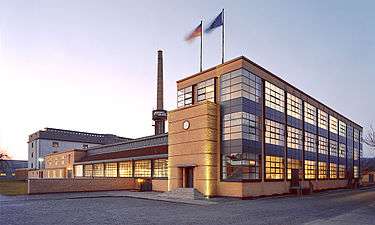 | Alfeld, 51°59′1″N 9°48′40″E / 51.98361°N 9.81111°E | Cultural: (ii), (iv) | 1.88 (4.6) | 2011 | Built by Walter Gropius in 1910, the factory designed to manufacture shoe last was renowned for redefining decorative values of the time period, particularly in the wide use of glass to render the building much more homogeneous, which foreshadowed his later work with the Bauhaus.[13] |
| Frontiers of the Roman Empire | 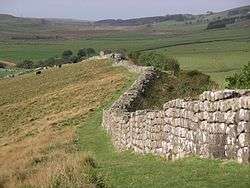 | Central Lowlands, Northern England, and Southern Germany 54°59′33.4″N 2°36′3.6″W / 54.992611°N 2.601000°W | Cultural: (ii), (iii), (iv) | 527 (1,300) | 1987 | Hadrian's Wall was built in 122 AD and the Antonine Wall was constructed in 142 AD to defend the Roman Empire from "barbarians".[14] The World Heritage Site was previously listed as Hadrian's Wall alone, but was later expanded to include all the frontiers of the Roman Empire at its zenith in the 2nd century, ranging from Antonine's Wall in the north to Trajan's Wall in eastern Europe.[15] |
| Garden Kingdom of Dessau-Wörlitz | 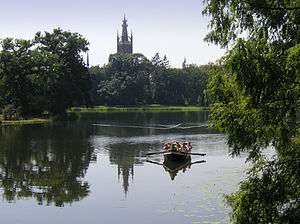 | Saxony-Anhalt, 51°50′33″N 12°25′14.988″E / 51.84250°N 12.42083000°E | Cultural: (ii), (iv) | 14,500 (36,000) | 2000 | "The Garden Kingdom of Dessau-Wörlitz is an outstanding example of the application of the philosophical principles of the Age of the Enlightenment to the design of a landscape that integrates art, education and economy in a harmonious whole."[16] |
| Hanseatic City of Lübeck |  | Schleswig-Holstein, 53°52′0.012″N 10°41′30.012″E / 53.86667000°N 10.69167000°E | Cultural: (iv) | 81 (200) | 1987 | Lübeck was the trading capital of the influential Hanseatic League, which monopolised trade in much of the Northern Europe. Although a fifth of the city was entirely destroyed in World War II, much of the original 12th-century architecture remains.[17] |
| Historic Centres of Stralsund and Wismar | 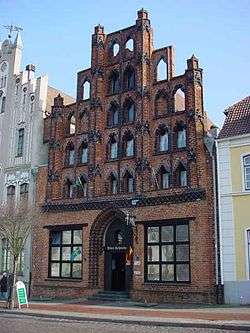 | Mecklenburg-Vorpommern, 54°18′9″N 13°5′7″E / 54.30250°N 13.08528°E | Cultural: (ii), (iv) | 168 (420) | 2002 | The two towns were major Hanseatic League trading centres in the 14th and 15th centuries. They then served as defensive and administrative centres for Sweden two hundred years later, notably during the Thirty Years' War. The architectural styles from both of these periods remain and are well-preserved.[18] |
| Luther Memorials in Eisleben and Wittenberg |  | Saxony-Anhalt, 51°51′52.992″N 12°39′10.008″E / 51.86472000°N 12.65278000°E | Cultural: (iv), (vi) | — | 1996 | |
| Margravial Opera House Bayreuth |  | Bayreuth, Bavaria 49°56′40″N 11°34′43″E / 49.94444°N 11.57861°E | Cultural: (i), (iv) | — | 2012 | |
| Maulbronn Monastery Complex | 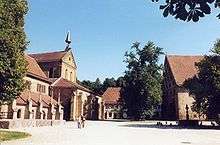 | Maulbronn, 49°0′2.988″N 8°48′47.016″E / 49.00083000°N 8.81306000°E | Cultural: (ii), (iv) | — | 1993 | The Cistercian Maulbronn Monastery is considered the most complete and best-preserved medieval monastic complex north of the Alps. The main buildings were constructed between the 12th and 16th centuries, along with the monastery walls. The monastery's church, mainly in Transitional Gothic style, helped spread the Gothic style across northern and central Europe. The monastery also had a large, elaborate water-management system.[19] |
| Messel Pit Fossil Site | | Messel, 49°55′0.012″N 8°45′14.004″E / 49.91667000°N 8.75389000°E | Natural: (viii) | 42 (100) | 1995 | Messel Pit is the richest site in the world for understanding the environment of the Eocene, between 57 million and 36 million years ago. In particular, it shows the early stages of mammalian evolution and includes exceptionally well-preserved mammal fossils. Some of the most notable discoveries include fully articulated skeletons and the contents of the stomachs of animals.[20] |
| Mines of Rammelsberg, Historic Town of Goslar and Upper Harz Water Management System |  | Goslar, Upper Harz, 51°49′12″N 10°20′24″E / 51.82000°N 10.34000°E | Cultural: (i), (ii), (iii), (iv) | 1,010 (2,500) | 1992 | The Upper Harz water management system was developed over a period of some 800 years to assist in mining and extracting ore. The mines and their ponds began under the Cistercian monks in the Middle Ages. However, most of the works were built from the end of the 16th century until the 19th century. It is made up of an extremely complex system of artificial ponds, small channels, tunnels and underground drains. The mines were a major site for mining innovation in the western world.[21] |
| Monastic Island of Reichenau | 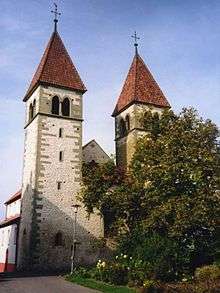 | Baden-Württemberg, 47°41′55.4″N 9°3′40.7″E / 47.698722°N 9.061306°E | Cultural: (iii), (iv), (vi) | — | 2000 | The site includes traces of the Benedictine monastery, founded in 724, which exercised remarkable spiritual, intellectual and artistic influence throughout the surrounding region. The churches of St Mary and Marcus, St Peter and St Paul, and St George, were mainly built between the 9th and 11th centuries. Their wall paintings and decorations show an impressive artistic activity.[22] |
| Museumsinsel (Museum Island), Berlin | 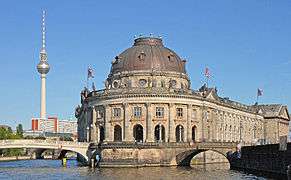 | Berlin, 52°31′11″N 13°23′55″E / 52.51972°N 13.39861°E | Cultural: (ii), (iv) | — | 1999 | The five museums on the Museumsinsel in Berlin, built between 1824 and 1930, are a unified but diverse collection of museum collections and buildings. Each museum was built to mesh with the collection and represents the aesthetic of the different times. The collections trace the development of civilizations throughout the ages.[23] |
| Muskauer Park / Park Mużakowski | .jpg) | Upper Lusatia, 51°34′45.5″N 14°43′35.2″E / 51.579306°N 14.726444°E | Cultural: (i), (iv) | 348 (860) | 2004 | A landscaped park astride the Neisse River and the border between Poland and Germany, it was created by Prince Hermann von Puckler-Muskau from 1815 to 1844. Designed as a ‘painting with plants’, it used local plants to enhance the existing landscape. The park spreads into the town of Muskau with parks and other green spaces. The site also features a reconstructed castle, bridges and an arboretum.[24] |
| Old Town of Regensburg with Stadtamhof | 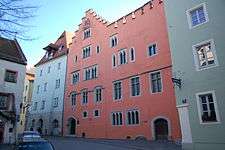 | Regensburg, 49°1′14″N 12°5′57″E / 49.02056°N 12.09917°E | Cultural: (ii), (iii), (iv) | 183 (450) | 2006 | This medieval town contains many notable buildings that span almost two millennia and include ancient Roman, Romanesque and Gothic buildings. Regensburg’s 11th- to 13th-century architecture created a town of narrow lanes flanked by tall buildings. It includes medieval patrician houses and towers, a large number of churches and monasteries as well as the 12th-century Stone Bridge. Regensburg was a European trade center in the Middle Ages and a political center of the Holy Roman Empire that turned to Protestantism.[25] |
| Palaces and Parks of Potsdam and Berlin | 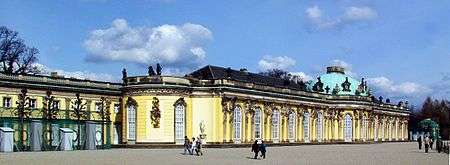 | Berlin, Potsdam, 52°23′59″N 13°1′59″E / 52.39972°N 13.03306°E | Cultural: (i), (ii), (iv) | 2,064 (5,100) | 1990 | This site contains 500 ha (1,200 acres) of parks and 150 buildings constructed between 1730 and 1916. It extends into the district of Berlin-Zehlendorf, with the palaces and parks lining the banks of the River Havel and Lake Glienicke. Voltaire stayed at the Sans-Souci Palace, built under Frederick II between 1745 and 1747.[26] |
| Pilgrimage Church of Wies | 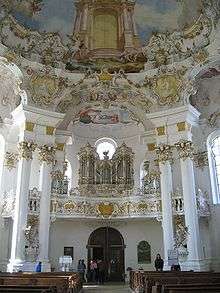 | Steingaden, 47°40′52.6″N 10°54′0.5″E / 47.681278°N 10.900139°E | Cultural: (i), (iii) | 0.1 (0.25) | 1983 | The Church of Wies (1745–54) is the work of architect Dominikus Zimmermann and is a masterpiece of the Bavarian Rococo.[27] |
| Prehistoric pile dwellings around the Alps |  | 47°16′42″N 8°12′27″E / 47.27833°N 8.20750°E | Cultural: (iv), (v) | 3,961 (9,790) | 2011 | Contains 111 small individual sites with the remains of prehistoric pile-dwelling (or stilt house) settlements in and around the Alps built from around 5000 to 500 B.C. on the edges of lakes, rivers or wetlands. While only some of the sites have been excavated, they contain a wealth of information on life and trade in agrarian Neolithic and Bronze Age cultures in Alpine Europe. Fifty-six of the sites are located in Switzerland.[28] |
| Primeval Beech Forests of the Carpathians and the Ancient Beech Forests of Germany | 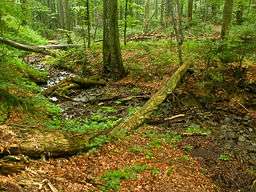 | 49°5′10″N 22°32′10″E / 49.08611°N 22.53611°E | Natural: (ix) | 33,670 (83,200) | 2007 | Primeval Beech Forests of the Carpathians, are used to study the spread of the beech tree (Fagus sylvatica) in the Northern Hemisphere across a variety of environments and the environment in the forest. The addition of the Ancient Beech Forests of Germany in 2011 included five forests totaling 4,391 hectares (10,850 acres) that are added to the 29,278 hectares (72,350 acres) of Slovakian and Ukrainian beech forests inscribed on the World Heritage List in 2007.[29] |
| Roman Monuments, Cathedral of St. Peter and Church of Our Lady in Trier | | Trier, 49°45′0″N 6°37′59″E / 49.75000°N 6.63306°E | Cultural: (i)(iii), (iv), (vi) | — | 1986 | The Roman colony at Trier was founded in the 1st century AD. It grew into a major town and became one of the capitals of the Tetrarchy at the end of the 3rd century. Many of the Roman era structures are still standing in Trier. The cathedral is the oldest church in Germany, being built on the ruins of Roman buildings by Maximin of Trier in 329-346.[30] |
| Speicherstadt and Kontorhous District |  | Hamburg, 53°32′53.9″N 10°00′10.5″E / 53.548306°N 10.002917°E | Cultural: (iv) | 26 (64) | 2015 | Speicherstadt and the adjacent Kontorhaus district are two densely built urban areas in the centre of the port city of Hamburg. Speicherstadt, originally developed on a group of narrow islands in the Elbe River between 1885 and 1927, was partly rebuilt from 1949 to 1967. It is one of the largest coherent historic ensembles of port warehouses in the world. |
| Speyer Cathedral | .jpg) | Speyer, 49°19′0″N 8°26′35″E / 49.31667°N 8.44306°E | Cultural: (ii) | — | 1981 | The romanesque Speyer Cathedral, was founded by Conrad II in 1030 and remodelled at the end of the 11th century. It was one of the grandest romanesque cathedrals in the Holy Roman Empire and the burial place of German emperors for almost 300 years.[31] |
| St Mary's Cathedral and St Michael's Church at Hildesheim | | Hildesheim, 52°9′10.008″N 9°56′38.004″E / 52.15278000°N 9.94389000°E | Cultural: (i), (ii), (iii) | 0.58 (1.4) | 1985 | The site consists of two churches in Hildesheim. The Ottonian romanesque St Michael's Church was built between 1010 and 1020. Inside it is decorated with a notable wooden ceiling, painted stucco-work, and the Bernward Column. The treasures of the Romanesque Hildesheim Cathedral contain the Bernward Doors, the Hezilo chandelier, the Azelin chandelier and other treasures.[32] |
| The Architectural Work of Le Corbusier, an Outstanding Contribution to the Modern Movement |  | Stuttgart, N46 28 6.29 E6 49 45.61 | Cultural: (i), (ii), (vi) | — | 2016 | Chosen from the work of Le Corbusier, the 17 sites comprising this transnational serial property are spread over seven countries and are a testimonial to the invention of a new architectural language that made a break with the past. They were built over a period of a half-century, in the course of what Le Corbusier described as “patient research”. The Complexe du Capitole in Chandigarh (India), the National Museum of Western Art, Tokyo (Japan), the House of Dr Curutchet in La Plata (Argentina) and the Unité d’habitation in Marseille (France) reflect the solutions that the Modern Movement sought to apply during the 20thcentury to the challenges of inventing new architectural techniques to respond to the needs of society. These masterpieces of creative genius also attest to the internationalization of architectural practice across the planet.[33] |
| Town of Bamberg | | Bamberg, 49°53′30″N 10°53′20″E / 49.89167°N 10.88889°E | Cultural: (ii)(iv) | 142 (350) | 1993 | In 1007, Bamberg became the center of a dioesce that was intended to help spread Christianity to the Slavs. During the 12th century the Bishops of Bamberg began a program of monumental public construction. The architecture that developed influenced construction in northern Germany and Hungary. In the 18th century it became a center of the Enlightenment when writers such as Hegel and Hoffmann settled in the town.[34] |
| Upper Middle Rhine Valley |  | Rhineland-Palatinate, Hesse, 50°10′25″N 7°41′39″E / 50.17361°N 7.69417°E | Cultural: (ii), (iv), (v) | 27,250 (67,300) | 2002 | A 65 km (40 mi) stretch of the Middle Rhine Valley in Germany. The region is home to many castles, historic towns and vineyards and has been an inspirition for many writers, artists and composers.[35] |
| Völklingen Ironworks |  | Völklingen, 49°14′39.984″N 6°50′59″E / 49.24444000°N 6.84972°E | Cultural: (ii), (iv) | — | 1994 | The recently closed ironworks are the only intact example in western Europe and North America of an intact ironworks built in the 19th and 20th centuries.[36] |
| The Wadden Sea |  | 53°31′43″N 8°33′22″E / 53.52861°N 8.55611°E | Natural: (viii), (ix), (x) | 968,393 (2,392,950) | 2009,2011,2014 | The Wadden Sea contains the Dutch Wadden Sea Conservation Area and the German Wadden Sea National Parks of Lower Saxony and Schleswig-Holstein. The coast line is generally flat and has may mudflats, marshes and dunes. The site covers two-thirds of the entire Wadden Sea and is home to many plant and animal species. It is a breeding ground for up to 12 millions birds annually and supports more than 10 percent of the population of 29 species. Was expanded in 2011 to include the German Wadden Sea National Park of Hamburg and in 2014 to include the Danish part of the Wadden Sea.[37] |
| Wartburg Castle |  | Eisenach, 50°58′0.4″N 10°18′25.2″E / 50.966778°N 10.307000°E | Cultural: (iii), (vi) | — | 1999 | Wartburg Castle is located on a 410 m (1230 ft) precipice above Eisenach. It expanded in several sections and only a few of the medieval structures still remain. The castle was rebuilt in the 19th century to its present appearance. Martin Luther translated the New Testament into German while in exile at Wartburg.[38] |
| Würzburg Residence with the Court Gardens and Residence Square | 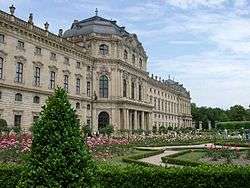 | Würzburg, 49°47′34.008″N 9°56′20.004″E / 49.79278000°N 9.93889000°E | Cultural: (i), (iv) | 15 (37) | 1981 | The large and ornate Baroque palace was created under the patronage of the prince-bishops Lothar Franz and Friedrich Carl von Schönborn. It is one of the largest palaces in Germany.[39] |
| Zollverein Coal Mine Industrial Complex |  | Essen, 51°29′29″N 7°2′46″E / 51.49139°N 7.04611°E | Cultural: (ii), (iii) | — | 2001 | The Zollverein industrial complex in Nordrhein-Westfalen contains all the equipment of a historic coal mine which started operation about 150 years ago. Some of the 20th century buildings are also notable.[40] |
Tentative list
The Tentative List consists of sites previously nominated, but not yet inscribed.[41]
| |
1999 | K | Heidelberg Castle and historical town | One of Germany's most famous castle ruins | On its 31st session in Christchurch, New Zealand, on 29 June 2007, UNESCO's World Heritage Committee remitted the request to include Heidelberg in the list of World Heritage Sites for the second time after 2005. A new attempt of filing for inclusion is yet unclear. |
 |
1999 | K | Schwetzingen Castle | Summer residence of Counts Palatine of the Rhine Charles Philip and Charles Theodor | On the 36th session in June/July 2012 in St. Petersburg, the request was remitted to the applicant. A new request is unclear. |
 |
1999 | K | Francke Foundations in Halle an der Saale | Established in 1698 by theologian and educator August Hermann Francke as cultural, scientific, educational and social institutions | The inclusion into the list is to be decided in 2016/17. |
 |
1999 | K | Naumburg Cathedral and the landscapes along the rivers Saale and Unstrut | ||
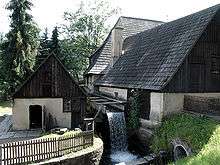 |
1999 | K | Ore Mountain Mining Region | ||
 |
2005 | K | Doberan Minster | Important monastery in the Baltic Sea region including a complete high gothic interior; | was already on the list of proposal of East Germany in 1984, active ambitions for nomination by the town of Bad Doberan since 2005, request for inclusion in the German list of proposals in 2012 filed at the Kultusministerkonferenz[42] |
 |
2007 | K | Schwerin Castle | The Schwerin ducal residence as a prime example of romantic historicism | Parliamentary vote of Mecklenburg-Vorpommern in 2007 to achieve a nomination, request for inclusion in the German list of proposals filed at Kultusministerkonferenz in June 2012[43] |
| |
2011 | K | Monuments and sites of the Vikings – Danevirke and Hedeby | International application | |
 |
2014 | K | Great Spas of Europe, including Baden-Baden, Bad Ems, Bad Kissingen and Wiesbaden. | International application | |
 |
2015 | K | Jewish Cemetery of Altona Königstraße, in Hamburg. | ||
 |
2015 | N | Alpine and pre-alpine meadow and marsh landscapes of “Werdenfelser Land”, “Ammergau”, “Staffelseegebiet” and “Murnauer Moos”, district Garmisch-Partenkirchen | ||
| 2015 | K | ShUM cities of Speyer, Worms and Mainz | |||
.jpg) |
2015 | K | The Bauhaus and associated sites in Weimar, Dessau and Bernau | ||
 |
2015 | K | Old Synagogue and Mikveh in Erfurt | ||
| 2015 | K | Darmstadt Artists’ Colony Mathildenhöhe | |||
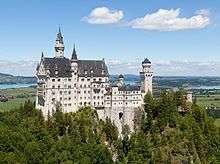 |
2015 | K | Dreams in Stone – the palaces of King Ludwig II of Bavaria: Neuschwanstein, Linderhof and Herrenchiemsee | ||
 |
2015 | K | Hydraulic Engineering and Hydropower, Drinking Water and Decorative Fountains in Augsburg | ||
 |
2015 | K | Caves with the oldest Ice Age art in Baden Württenberg | ||
 |
2015 | K | Luther memorials in Saxony-Anhalt, Saxony, Bavaria and Thuringia | ||
| 2015 | Frontiers of the Roman Empire
in Bavaria |
International application with Austria |
Former site
One site has been struck from the list.
| Site | Image | Location | Criteria | Area ha (acre) | Year | Description |
|---|---|---|---|---|---|---|
| Dresden Elbe Valley |  | Saxony, 51°2′24″N 13°49′16″E / 51.04000°N 13.82111°E | Cultural: (ii), (iii), (iv), (v) | 1,930 (4,800) | 2004–2009 | The Elbe flows through a range of culturally relevant landscapes in Saxony, including rural villages, former palace grounds, and the historic old town of Dresden. The site was removed from the list due to concerns about the construction of the Waldschlösschen Bridge.[44] |
See also
- UNESCO World Heritage Site
- List of World Heritage Sites in Western Europe
- Tourism in Germany
- List of national parks in Germany
- Kulturdenkmal
- Deutsche Stiftung Denkmalschutz
External links
- German Commission of UNESCO
- UNESCO volunteer organisation of Germany
- Wonders of World Heritage - A DW Guide to all German sites (8 different routes)
- 360 panorama views of all German World Heritage sites
References
- ↑ Naturstätten des UNESCO Welterbes in Deutschland: Bestandsaufnahme und Perspektiven – KATALYSE Umweltjournal, 2002 (German)
- ↑ "Aachen Cathedral". UNESCO. Retrieved 29 October 2011.
- ↑ "Abbey and Altenmünster of Lorsch". UNESCO. Retrieved 29 October 2011.
- ↑ "Bauhaus and its Sites in Weimar and Dessau". UNESCO. Retrieved 29 October 2011.
- ↑ "Bergpark Wilhelmshöhe". UNESCO. Retrieved 24 June 2013.
- ↑ "Berlin Modernism Housing Estates". UNESCO. Retrieved 15 February 2012.
- ↑ "Castles of Augustusburg and Falkenlust at Brühl". UNESCO. Retrieved 30 October 2011.
- ↑ "Town Hall and Roland on the Marketplace of Bremen". UNESCO. Retrieved 21 February 2012.
- ↑ "Classical Weimar". UNESCO. Retrieved 39 October 2011. Check date values in:
|access-date=(help) - ↑ "Collegiate Church, Castle, and Old Town of Quedlinburg". UNESCO. Retrieved 30 October 2011.
- ↑ "Cologne Cathedral Number 1 Attraction" (PDF) (Press release). Cologne Tourist Board. 19 January 2011. Retrieved 20 December 2012.
- ↑ "Cologne Cathedral". UNESCO. Retrieved 30 October 2011.
- ↑ "Fagus Factory in Alfeld". UNESCO. Retrieved 6 November 2011.
- ↑ "Frontiers of the Roman Empire". UNESCO. Retrieved 6 November 2011.
- ↑ "World Heritage List". UNESCO. Retrieved 27 July 2009.
- ↑ "Garden Kingdom of Dessau-Wörlitz". UNESCO. Retrieved 6 November 2011.
- ↑ "Hanseatic City of Lübeck". UNESCO. Retrieved 7 November 2011.
- ↑ "Historic Centres of Stralsund and Wismar". UNESCO. Retrieved 7 November 2011.
- ↑ "Maulbronn Monastery Complex". UNESCO. Retrieved 15 February 2012.
- ↑ "Messel Pit Fossil Site". UNESCO. Retrieved 15 February 2012.
- ↑ "Mines of Rammelsberg, Historic Town of Goslar and Upper Harz Water Management System". UNESCO. Retrieved 15 February 2012.
- ↑ "Monastic Island of Reichenau". UNESCO. Retrieved 15 February 2012.
- ↑ "Museumsinsel (Museum Island), Berlin". UNESCO. Retrieved 15 February 2012.
- ↑ "Muskauer Park / Park Mużakowski". UNESCO. Retrieved 15 February 2012.
- ↑ "Old Town of Regensburg with Stadtamhof". UNESCO. Retrieved 15 February 2012.
- ↑ "Palaces and Parks of Potsdam and Berlin". UNESCO. Retrieved 15 February 2012.
- ↑ "Pilgrimage Church of Wies". UNESCO. Retrieved 22 February 2012.
- ↑ "Prehistoric Pile dwellings around the Alps". UNESCO. Retrieved 14 February 2012.
- ↑ "Primeval Beech Forests of the Carpathians and the Ancient Beech Forests of Germany". UNESCO. Retrieved 14 February 2012.
- ↑ "Roman Monuments, Cathedral of St. Peter and Church of Our Lady in Trier". UNESCO. Retrieved 21 February 2012.
- ↑ "Speyer Cathedral". UNESCO. Retrieved 20 February 2012.
- ↑ "St Mary's Cathedral and St Michael's Church at Hildesheim". UNESCO. Retrieved 20 February 2012.
- ↑ "The Architectural Work of Le Corbusier, an Outstanding Contribution to the Modern Movement". UNESCO. Retrieved 17 July 2016.
- ↑ "Town of Bamberg". UNESCO. Retrieved 21 February 2012.
- ↑ "Upper Middle Rhine Valley". UNESCO. Retrieved 21 February 2012.
- ↑ "Völklingen Ironworks". UNESCO. Retrieved 22 February 2012.
- ↑ "The Wadden Sea". UNESCO. Retrieved 26 October 2015.
- ↑ "Wartburg Castle". UNESCO. Retrieved 22 February 2012.
- ↑ "Würzburg Residence with the Court Gardens and Residence Square". UNESCO. Retrieved 22 February 2012.
- ↑ "Zollverein Coal Mine Industrial Complex in Essen". UNESCO. Retrieved 22 February 2012.
- ↑ "Tentative Lists". World Heritage Center. Unesco. Retrieved 11 June 2015.
- ↑ "Landtag Mecklenburg-Vorpommern – Plenarprotokoll" [Mecklenburg-Vorpommern State Parliament – Plenary Debate Transcript] (PDF) (in German) (6/17). Mecklenburg-Vorpommern State Parliament. 23 May 2012: 69.
- ↑ "Mitte Juni Antrag bei der Kultusministerkonferenz eingereicht. Schweriner Schlossensemble UNESCO-Welterbe?" [World Heritage Request for Schwerin Castle filed in mid-June. Schwerin Castle now a UNESCO World Heritage?] (in German). Mecklenburg-Vorpommern State Parliament. Retrieved 17 April 2014.
- ↑ "Dresden Elbe Valley". UNESCO. Retrieved 7 September 2016.
This article is issued from Wikipedia - version of the 10/15/2016. The text is available under the Creative Commons Attribution/Share Alike but additional terms may apply for the media files.
